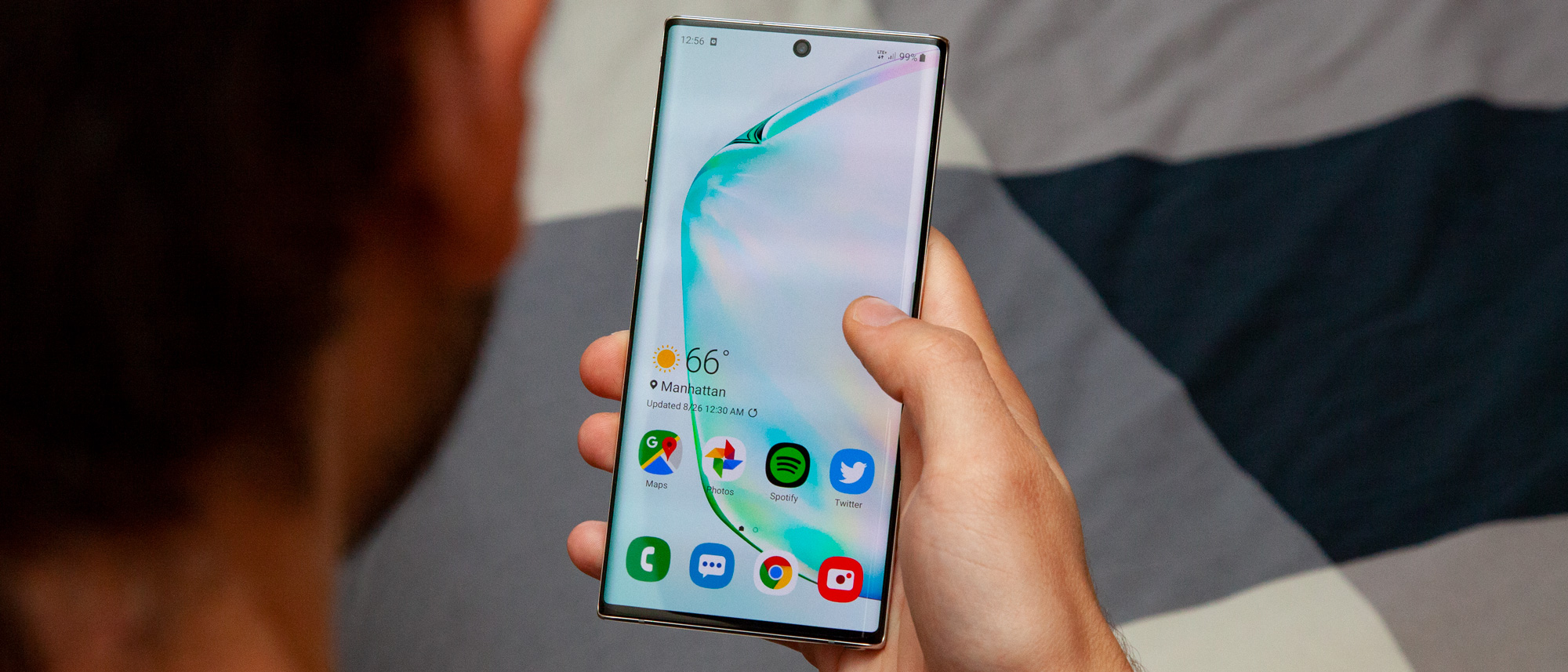Tom's Guide Verdict
The Samsung Galaxy Note 10 delivers epic battery life and a super-bright screen in a phenomenally compact design, though its software features could use some work.
Pros
- +
Compact design with huge display
- +
256GB storage standard
- +
Live Focus now for video
- +
Fastest charging yet in a Samsung phone
Cons
- -
No headphone jack or microSD
- -
Handwriting conversion is cumbersome
- -
Aura Glow is a fingerprint magnet
- -
DeX for PC needs work
- -
Battery life is below average
Why you can trust Tom's Guide
Samsung built the Galaxy Note brand on delivering the best big-screen phones around, but the best thing about the Samsung Galaxy Note 10 is how delightfully small it is.
The 6.3-inch Note 10 is one of the most compact big-screen phones yet, thanks to its nearly bezel-free Infinity-O screen — and some features Samsung left on the cutting room floor. The Note 10 also boasts several S-Pen enhancements (including gestures), introduces helpful video recording features and a new way to mirror the phone on a PC.
Although the $949/£869 Note 10 doesn't represent the pinnacle of Samsung's phablets, it should hit the sweet spot for most people in terms of size and specs. The idea of a compact phablet might sound crazy, but it actually makes a whole lot of sense when you use it.
However, there are some trade-offs. You won’t find a headphone jack on the Note 10, and the microSD card slot is gone, too. The Note 10’s screen also isn’t as sharp as its predecessor's, though you'd be hard pressed to notice a difference between them.
Today the Note 10 is still a great device, even with the Samsung Galaxy Note 20 now out. The new Note raises the screen size to 6.7 inches, making it potentially unsuitable to those interested in the Note 10 for its smaller footprint. It also features half the storage and no microSD slot for expandability. In other respects, the Note 20 seems like a worthy update; you can read our Samsung Galaxy Note 20 vs. Galaxy Note 10 face-off for a deeper explanation into how the two phones differ.
Read on for our in-depth Samsung Galaxy Note 10 review.
- Samsung Galaxy Note 20 review: Everything you need to know about the latest Note
- Galaxy Note 10 vs. Galaxy Note 9: Should you upgrade?
- Plus: Samsung Galaxy Z Fold 2 review: The ultimate foldable phone has arrived
Samsung Galaxy Note 10 review: Cheat sheet
- The Galaxy Note 10 isn't just thinner and lighter than the Galaxy Note 9; it's the most compact phone ever with a 6.3-inch screen. In fact, it's so tiny for its display size that we consider it among the best small phones you can buy.
- Samsung kept the cameras mostly the same compared to the Galaxy S10, with wide, ultrawide and telephoto lenses. But it did bring Live Focus effects to video. A software update has brought some of the Galaxy S20's camera features to the Galaxy Note 10.
- The Snapdragon 855 inside the Galaxy Note 10 delivers impressive performance, though other flagship Android phones — especially those with Qualcomm's newer Snapdragon 865 chipset — outperform it, and Apple's A13 Bionic chip in the iPhone 11 range absolutely smokes it.
- The S Pen performs Air Actions, such as changing camera modes with a wave of your hand. You can also convert handwriting to text, but it's not seamless.
- Samsung killed both the headphone jack and microSD card slot, but at least the bundled USB-C headphones offer noise cancelling.
- The Galaxy Note 10 Plus has a bigger 6.8-inch screen, more RAM, larger battery and fourth camera on the back for depth sensing, but it costs $150/£130 more.
Samsung Galaxy Note 10 review: Price and availability
The Galaxy Note 10 is available for $949/£869, though we recommend you check out all the best Galaxy Note 10 deals out there before you decide where to buy. All of the major U.S. carriers are selling the Note 10, including AT&T, Verizon, Sprint and T-Mobile.
Get instant access to breaking news, the hottest reviews, great deals and helpful tips.
Samsung is currently offering an instant credit of $220 or more when you trade-in a device in good condition. Find out more details at Samsung.com.
Samsung Galaxy Note 10 specs
| Header Cell - Column 0 | Galaxy Note 10 |
|---|---|
| Price | $949/£869 |
| Display | 6.3-inch Dynamic AMOLED (2280x1080) |
| CPU | Snapdragon 855 (US); Exynos 9825 (WW) |
| RAM | 8GB |
| Storage | 256GB |
| microSD Slot? | No |
| Rear cameras | 12MP wide (ƒ/1.5-f/2.4); 16MP ultrawide (ƒ/2.2); telephoto (ƒ/2.1) |
| Front cameras | 10MP (ƒ/2.2) |
| Battery | 3,500 mAh |
| Charging | 25W; 45W optional |
| OS | Android 10 with Samsung OneUI |
| Colors | Aura Glow, Aura White, Aura Black, Aura Blue |
| Size | 5.9 x 2.8 x 0.31 inches |
| Weight | 5.9 ounces |
Samsung Galaxy Note 10 review: Design
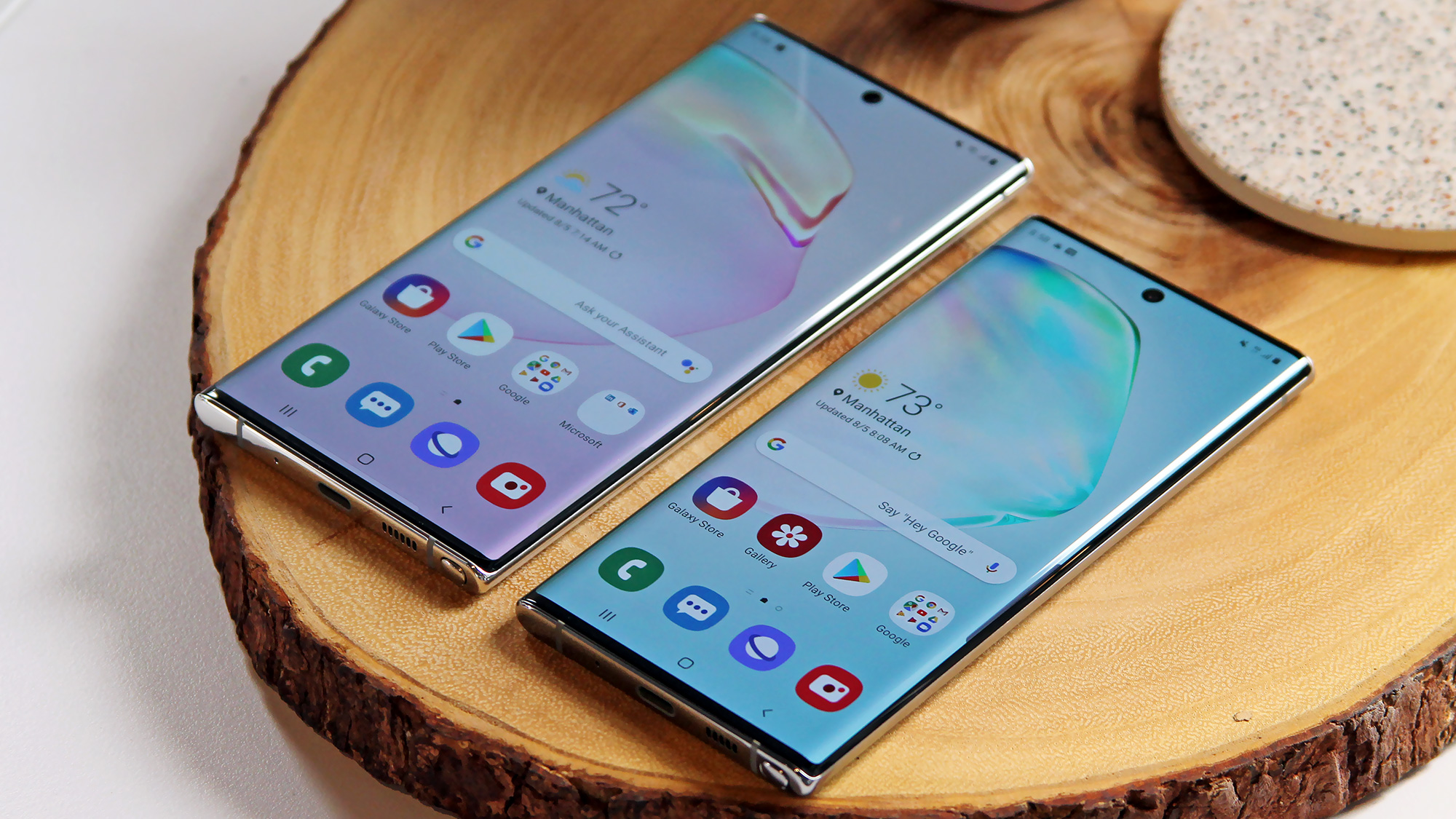
The Galaxy Note 10 is easily one of the most striking phones out there, especially if you go for the Aura Glow color. That model gives off a silvery iridescence that changes hues as light strikes it at different angles. You can also get it in Aura White, Aura Black and Aura Blue, with that last color exclusive to Best Buy and Samsung.com. Some regions receive additional colors, like Aura Red, that aren't available in North America.
The most impressive thing about the Galaxy Note 10 is how it feels in your hand. At 6.3 inches, the Galaxy Note 10 has a slightly smaller screen than the 6.4-inch Galaxy Note 9, but it’s remarkably thinner and lighter. The Note 10 weighs just 5.9 ounces and is 5.9 x 2.8 x 0.31 inches thick, compared to a whopping 7.1 ounces and 6.3 x 3 x 0.34 inches for 2018's Galaxy Note 9.
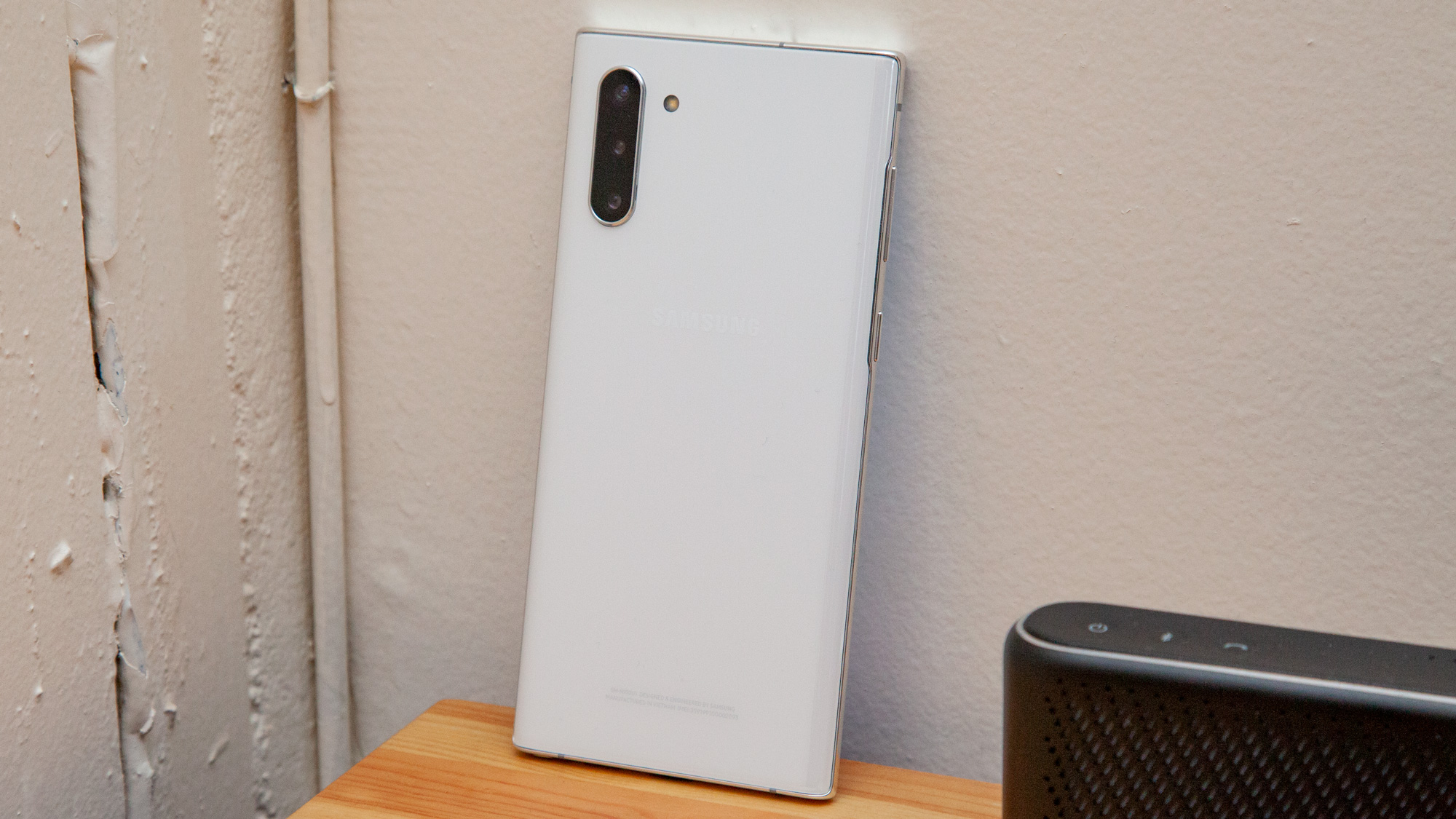
In fact, Samsung’s new phablet doesn't feel like a phablet at all when you hold it; it just feels normal. For a sense of perspective, the Note 10 is roughly two-tenths of an inch longer and a tenth wider than the Google Pixel 3 I regularly use, but packs a screen that's a whopping 0.8 inches larger from corner to corner.
The result is a Note that is surprisingly comfortable to use one-handed. If you're especially mindful about owning a phone that slips easily into your pocket, or generally isn't cumbersome to live with, the Note 10 offers the biggest possible display in the smallest possible footprint right now. The steeply-sloped sides and miniscule bezels can occasionally yield unintentional touches at the edges of the display, though I generally found Samsung's palm rejection algorithm to be good at determining when I actually meant to interact with the device.
Overall, there's little to be annoyed with here from a design perspective. For what it's worth, I don't like that the power button and volume controls are both on the left side of the phone; as I'm right-handed, I'd prefer them to be on the opposite side. Southpaws may be pleased, though perhaps Samsung could have split the difference and put some keys on the left and others on the right.

Another minor gripe: depending on the color you get, the Note 10 can be a fingerprint super-magnet. Lots of handsets attract prints these days, but because the Aura Glow finish is literally that of a mirror with neat rainbow effects, if you look at the back of the phone from any perspective, smudges and smears are guaranteed to catch your eye. This is less true of the other colorways — the presence of a consistent hue can somewhat cloak that ugliness. But if you're the type of person that finds yourself frequently wiping your phone with a microfiber cloth, you're going to get a repetitive stress injury polishing the Aura Glow Note 10.
Yes, the headphone jack is gone. Samsung ditched the 3.5-millimeter jack on both Note 10 models, as well as the microSD card slot on the smaller one in particular to achieve a sleeker design. On the plus side, Samsung is bundling AKG headphones in the box that use USB Type-C, and the Note 10 is at least still rated IP68 water-resistant, earning it a spot on our list of the best waterproof phones.
Like Samsung's other recent premium handsets, the Note 10 has an ultrasonic fingerprint sensor baked into the display. The sensor is usually responsive and secure, though users have discovered that it can be easily fooled if certain third-party screen protectors have been applied to the device. A subsequent software update from Samsung reportedly fixes this issue, though it's something buyers may want to test themselves.
Samsung Galaxy Note 10 review: Display
The Galaxy Note 10 features a 6.3-inch Infinity-O display, which has a cutout located in the top center of the panel. Personally, I find the Note 10’s hole punch less distracting than the one on the Samsung Galaxy S10, which is on the right side.
The cutout is most obvious when you’re using an app with a white background, as you'd expect, though the diameter of the Note's front-facing camera is smaller than that of the S10 or S10e. In other words, it's not nearly as obtrusive as it could be. In fact, after a while, you start to forget it's there.
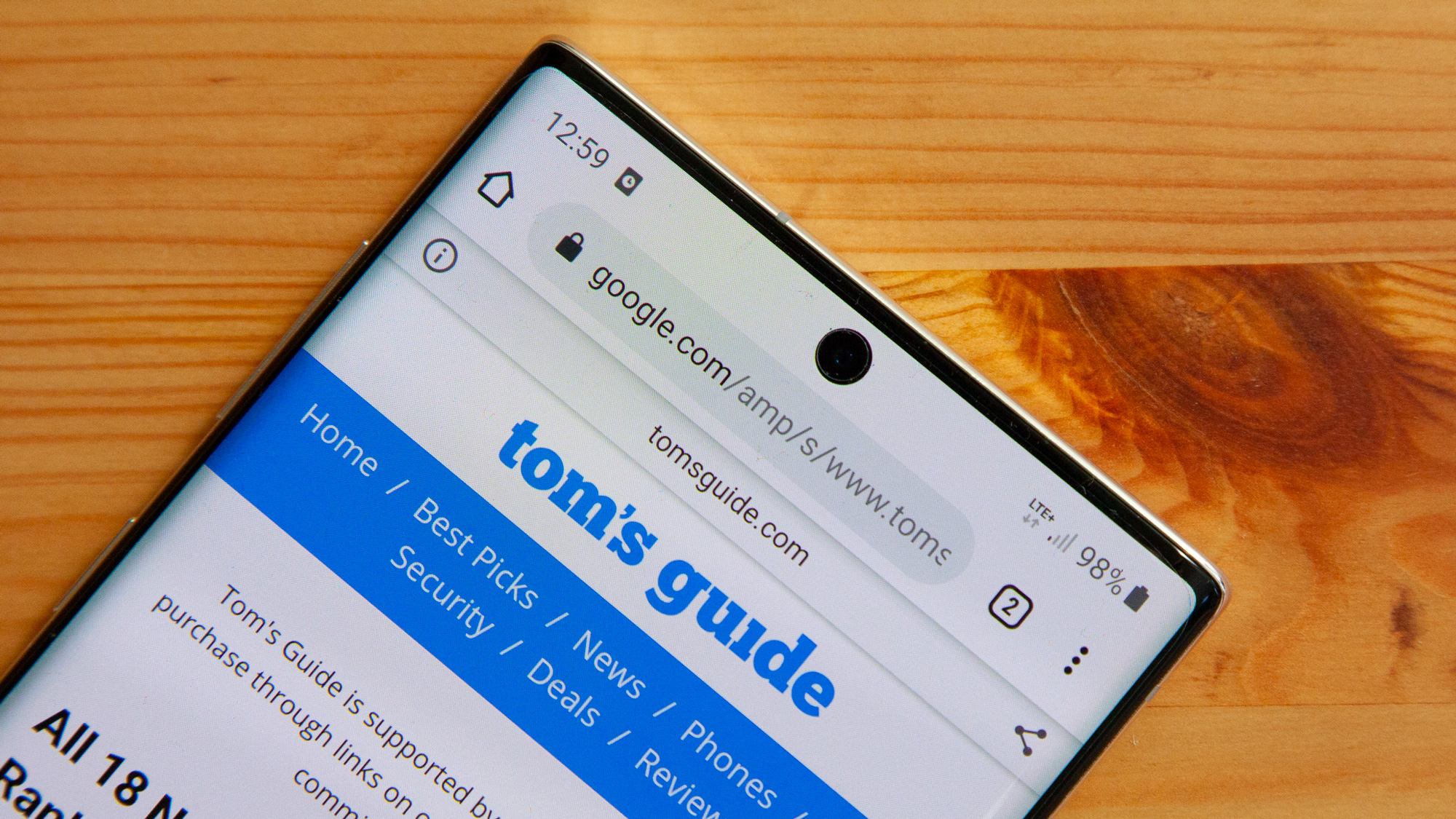
One downgrade from the Note 9 to the Note 10 concerns the quality of the screen. The Note 10’s Dynamic AMOLED display packs 2280x1080 pixels, compared to 3040x1440 panel in the Note 10 Plus. That said, the resolution decrease sounds worse than it is. I don’t think most people will notice a difference, and you still get the same great colors and HDR10+ certification as you do on the larger model.
In terms of numbers, the Galaxy Note 10 offers one of the brightest and most accurate displays we've tested to date. At 674 nits of full-screen brightness, the Note 10's panel is just overshadowed by the Plus variant's 686 nits. The smaller device's screen still produces accurate colors, as evidenced by its 0.26 Delta-E score (numbers closer to zero are better). In Natural mode, the Note 10's screen covers a good swath of the sRGB spectrum at 125.1%. The Note 10 Plus delivered results of 0.25 and 124.6% in these categories, respectively. (As with all other Samsung phones, there's an optional Vivid color profile, too, if you prefer more saturated hues).
But it's the brightness that makes all the difference. Cranked up to the highest setting, the Note 10's panel can illuminate details that would go unseen on other handsets' screens, while still maintaining the perfect blacks you'd expect from AMOLED technology. Watching the teaser trailer for El Camino, the Breaking Bad movie, some of the shadowy figures in the interrogation room were more clearly discernible on Samsung's display compared to when viewing the same clip on a Pixel 3.
Ultimately, if you're after the sharpest display you can get, the 6.8-inch Note 10 Plus sports a higher pixel density of 498 pixels-per-inch, compared to 401 on this smaller model. Unfortunately, neither model has a 120Hz refresh rate like the OnePlus 8 Pro, so you miss out on silky-smooth animations and scrolling. That would have been nice to see; while the Note 10's screen is among the finest the industry has to offer right now, without that superfast refresh rate, it doesn't feel like much of a generational leap.
Samsung Galaxy Note 10 review: S Pen
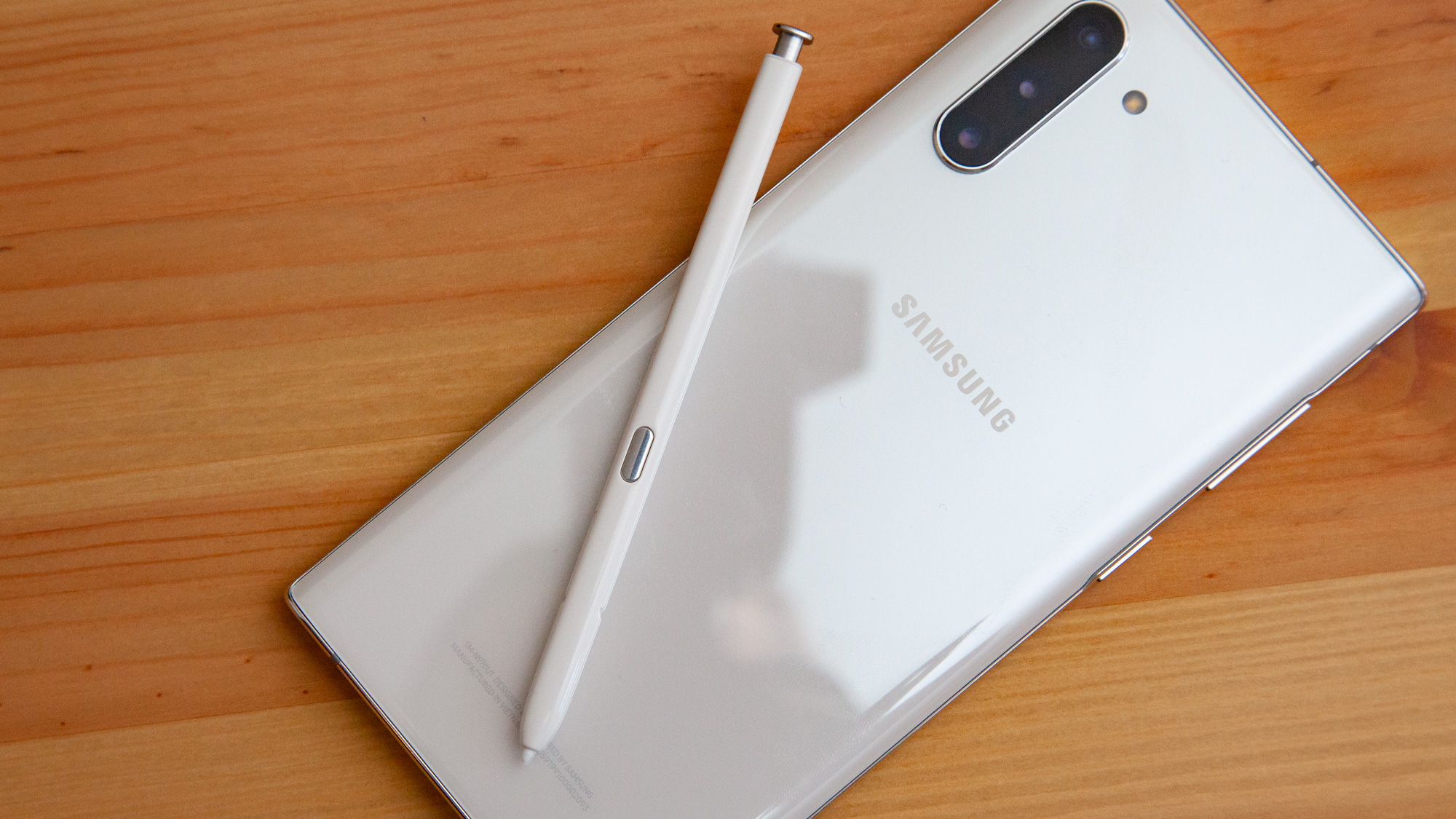
The S Pen has gained some new tricks on the Galaxy Note 10 — though some of them come across as more gimmicky than useful.
One of the S Pen's hallmark features has been the ability to convert handwriting to text. New for the Note 10, Samsung's OneUI software now offers a transcription-and-export option, that will allow you to save the note as text and send it to a Word doc, PDF or another file type, in one action. It's a clever feature, though much like the S Pen's other powerful transcription capabilities, it's somewhat convoluted to access.
For example, if you scrawl out a Screen Off Memo or Quick Memo outside of the Samsung Notes app, you'll have to tap an on-screen button to move that document to the Notes app before you can start converting phrases and entire documents. Additionally, if you'd rather have handwriting-to-text conversion carried out as you write on the fly, you'll have to open the keyboard, swipe over to the keyboard page that offers additional features and tap another icon before you can begin writing with live transcription.
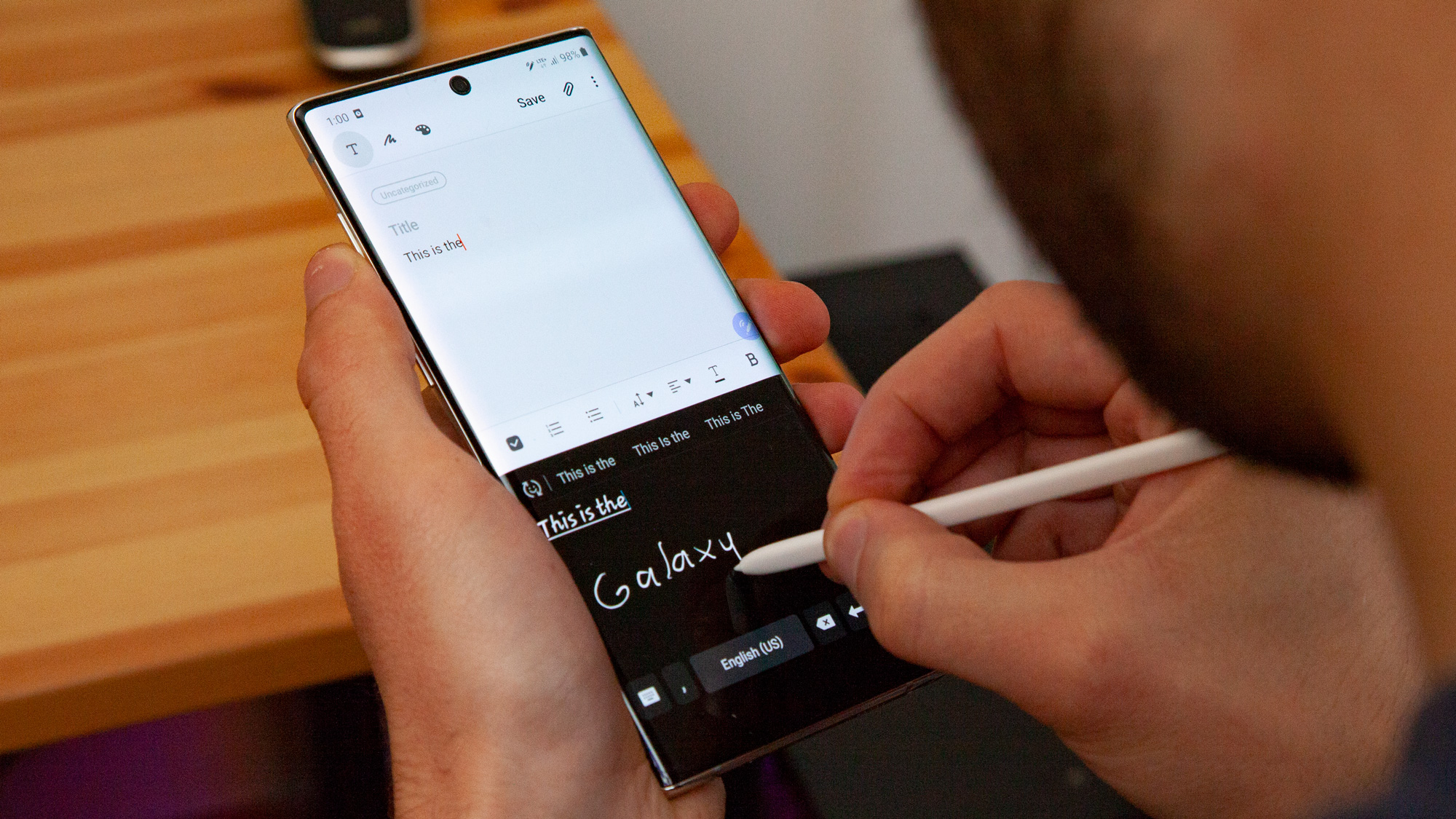
While I appreciate that Samsung offers so many ways to use the S Pen to write, and while transcription works well in practice, the company desperately needs to make it easier to locate these features. Having to move a note I'm already taking to a separate app so I can edit and transcribe it creates a strange and unnecessary extra step. And I suspect when taking notes, most people would probably prefer live transcription, so burying that feature behind several layers of keyboard menus doesn't seem like the brightest idea either.
Thankfully, you don’t have to apply nearly as much effort to use the new Air Actions gestures for the S Pen. For instance, you can change camera modes in the camera app just by swiping the stylus in the air while you press the button, and you can zoom in by making a circular motion with the S Pen. This worked, but it took some practice to get the hang of. As I discovered, you don't want to hold the button indefinitely — only when you're actively making the motion.
The Note 10 could use properly-executed software to match its phenomenal hardware.
At this point, it's difficult to imagine a scenario in which Air Actions would be especially beneficial, save for the classic tripod scenario. Samsung started opening up the S Pen SDK to developers last year, so there is an opportunity for Air Actions to flourish, if developers choose to take advantage of them. At the moment, though, the feature isn't even present in most of the Note 10's first-party software, so there's still lots of work to be done on Samsung's end.
Last but not least, there’s a new AR Doodle feature that has the potential to create viral moments with your friends. Using the S Pen, you can draw on a live view of a subject or multiple subjects, and whatever you draw on them (a hat, mustache, etc.) will travel with them as they move about the frame.
The Galaxy Note 10 AR Doodle feature is cool and creepy! Watch this. #ARDoodle #SamsungEvent #samsunggalaxynote10 pic.twitter.com/XU3Ih3KeZJAugust 7, 2019
The AR Doodle feature is cute and yields silly results, as you can see in the above demo. Ultimately, though, it's one of those passing fads that wears thin pretty quickly. And while it's technically impressive, you'll have to be at least a decent artist if you want to get the most out of AR Doodle.
Samsung Galaxy Note 10 review: Camera

Samsung decided to use the same camera sensors on the Galaxy Note 10 as on the Galaxy S10, which means you should not expect a leap in performance when taking still shots. Since the Note 10 came out in 2019, Samsung has launched the Galaxy S20 family, which features more advanced cameras, particularly on the high-end Galaxy S20 Ultra. A software update has brought some of the S20's camera features — such as Single Take, which captures a number of shots at once, and Night Hyperlapse capabilities — to the Galaxy Note 10.
The back of the phone houses a triple-camera setup that includes a wide-angle 12MP shooter, an ultra-wide camera that takes 123-degree pics, and a 12MP telephoto lens that handles bokeh-effect portraits and offers 2x optical zoom. I say limited because phones like the Huawei P30 Pro already offer a 5x optical zoom using clever prism technology. The Galaxy Note 10 Plus offers a fourth sensor, a VGA depth camera that’s optimized for taking bokeh shots and better depth effects.
The cameras inside the Note 10 are the same as those the Galaxy S10 series used, so we didn't expect to see photos that looked especially different from Samsung's previous flagships. The company's optics and image processing algorithms have always had a penchant for scenes that boost low-light visibility, often at the expense of dynamic range. In this pair of photos, taken within New York's Bryant Park, the Note 10 delivers a flatter-seeming image with better detail in the shadows, but less in the highlights compared to the Pixel 3.
Heading a few blocks over to Times Square, we're met with a scenario that better plays to the Note 10's advantages. The strange green cast present in Samsung's Bryant Park shot is thankfully gone here. Instead, the Note 10 does a better job of exposing the entirety of the frame than the Pixel 3. Google's handset tends to prefer warmer, darker images, though in this case, the Pixel's lighting is much too dim compared to the actual conditions at the time. Still, I prefer the color Google's device pulls out of the clouds and sky.
Looking out in the middle of a street in Brooklyn at dusk, the Note 10 appears to have been a little overwhelmed by its surroundings. There's a warm glow that pervades certain aspects of the shot, and a distinct lack of sharpness present in the trees, the texture of the asphalt and the cars that line the road. The Pixel 3's attempt here seems much more composed and consistent. It's important to point out here that neither device was tuned to night mode for this particular comparison.
However, each phone's respective night mode was used for this pair of shots captured near Manhattan's Herald Square. Straight away, you can see that the Note 10's rendition is a bit warmer and softer in the same key areas, like the sides of buildings and texture of the street. Samsung's processing mitigates blowing out the highlights compared to Google's, although on the flip side, the Pixel 3 avoids the over-pronounced glow radiating from the overhead lamps. Again, Google's handset claims the sharper, more natural vibe here.
Finally, comparing the Note 10's Live Focus feature against the Pixel 3's shallow depth-of-field effects, it's clear to see Samsung still has work to do on the portrait front. While the deep shadows on my colleague Shaun's face lend an over-dramatic look to an otherwise well-lit indoor shot, the Note 10 goes much too far in the other direction, diminishing contrast to a fault. Shaun's hair, skin, t-shirt and tattoos all just come through so much more clearly through the Pixel's lens.
Where Samsung hopes the Note 10 stands out is with its video prowess. The phone sports a Live Focus mode for video, which lets you blur the background and add special effects — like colorizing only the subject while keeping the background black and white.
The new video features aren't quite professional grade as Samsung suggests, though they do work pretty well. Capturing video with blurred backgrounds lends a cheesy rom-com effect to video that isn't perfect (the bokeh fades in and out at times), but looks good enough for the small screen. And editing these clips is a breeze thanks to the S Pen and Samsung's redesigned video editor, which makes it easier to trim clips and perform other tasks with greater precision than using your finger alone.
Samsung Galaxy Note 10 review: Performance
The Galaxy Note 10 is one of the fastest Android phones, thanks to Qualcomm's Snapdragon 855 CPU. It's not the newest mobile processor on the market, though it certainly delivers enough power for most people.
The Galaxy Note 10 was one of a small group of phones (including the OnePlus 7 Pro) upon its launch to boast UFS 3.0 storage for snappier read and write speeds. You get 256GB of storage standard, complemented by 8GB of RAM; the Plus model packs 12GB of RAM. Truthfully, though 8GB is enough — the smaller Note 10 never stumbled during a week of use, whether I was gaming or writing, and never seemed wanting for more power.

We ran our Samsung Galaxy Note 10 through Geekbench 4 and 3DMark's Sling Shot Extreme OpenGL ES 3.1 graphics test, and were met with impressive — if not record-setting — results. In Geekbench, which measures overall system performance, the Note 10 turned in a result of 10,906. That's roughly 300 points behind the Note 10 Plus (which features 4GB more RAM), and 600 points behind the iPhone XS Max and its A12 Bionic chipset.
The Note 10 performed better relative to the iPhone XS Max in 3DMark's graphics benchmark. There, the phablet notched a score of 5,374 — a full 1,000 points better than the 4,339 result from that iPhone, but a bit behind the iPhone 11 Pro Max's 5,392 score. However, other Android phones, including the Note 10 Plus (5,781), OnePlus 7 Pro (5,581) and even the Galaxy S10 Plus (5,648), all had it smoked.
Samsung Galaxy Note 10 review: DeX for PC
If you like the idea of using your Note 10 on a bigger screen, Samsung makes it easy with its upgraded DeX functionality. All you need is the provided USB Type-C cable that comes with the phone, as well as the DeX desktop app for your Windows PC or Mac, and you can run Android applications on your computer's display and manage your files through a phone-like interface, only on the big screen.

The ability to use DeX without Samsung's dedicated DeX Station isn't new; the Galaxy Note 9 introduced support to run the software on an external display using a USB-C-to-HDMI cable. The prospect of transforming your Note into a makeshift workstation with nothing more than a cable seemed like a great addition to DeX's repertoire.
In theory, being able to access DeX by plugging your Note 10 into your PC should expedite file management, which could be useful. However, our experience with the software wasn't as smooth as we hoped.
Running DeX windowed on a PC is a somewhat laggy, low-quality experience, with strange limitations. For example, you currently can move files from your computer to your phablet by dragging them onto the DeX desktop, but not the other way around. Speaking of which, it's difficult to understand why someone would prefer to use DeX through their computer if they already have access to Windows or Mac to begin with.
It's worth pointing out the Galaxy Note 20 has the ability to project DeX wirelessly to Miracast-supported displays. This feature will come to the Note 10 and Note 10 Plus as part of those phones' imminent One UI 2.5 updates, alongside some of the Note 10's other new S Pen and note-taking features. That presents another reason to get last year's model, if you can procure one at a compelling discount.
Samsung Galaxy Note 10 review: Battery life and charging
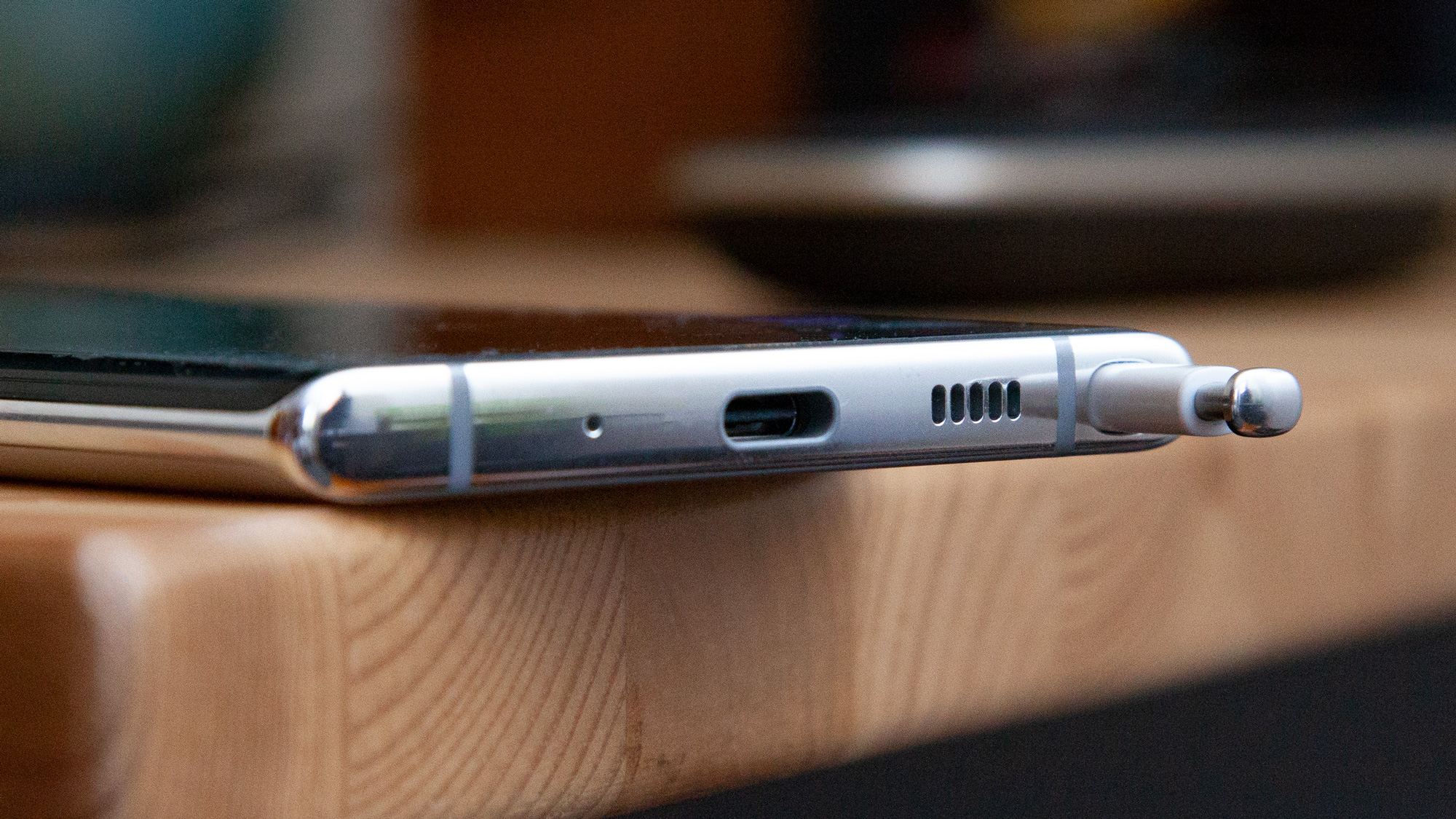
With a capacity of 3,500mAh, the Galaxy Note 10's battery is smaller than both the Galaxy Note 9 (4,000mAh) and Galaxy Note 10 Plus (4,300mAh).
In Tom's Guide's custom battery test, which forces the phone to endlessly load webpages on T-Mobile's LTE network at 150 nits of screen brightness, the Note 10 lasted for an average of 9 hours and 25 minutes across three sessions.
Those times are well below the smartphone average of 10:14, not to mention the Note 10 Plus' 10:47 result over multiple tests — understandable, given that the Plus features an 800-mAh larger battery compared to the standard model. An earlier test of the regular Note 10's battery yielded a score of 14:33, due to an error in testing.
The Note 10's current average of 9:25 is below what we've witnessed from other handsets, and well short of the best phone battery life we've seen, as the table below indicates.
| Phone | Battery Life |
|---|---|
| Samsung Galaxy S10 Plus | 12:35 |
| Apple iPhone 11 Pro Max | 11:44 |
| Samsung Galaxy Note 9 | 11:26 |
| Samsung Galaxy Note 10 Plus | 10:47 |
| Apple iPhone XS Max | 10:38 |
| Samsung Galaxy S20 Plus | 10:31 |
| Google Pixel 4 XL | 9:42 |
| OnePlus 7 Pro | 9:31 |
| Samsung Galaxy Note 10 | 9:25 |
While roughly 9-and-a-half hours of battery life is not necessarily a deal-breaker, it does make the Note 10 a less compelling proposition, and gives those especially concerned about longevity on a charge a reason to spring for the Note 10 Plus instead.
At least when it’s time to juice back up, you’ll be happy to know that the Note 10 ships with a 25-watt charger, which is the same that came in the box with the Galaxy S10 5G. In our testing, the Note 10 went from dead to 26% in 15 minutes, and hit 47% after a half hour. That's not too shabby, though the Note 10 Plus can achieve even faster speeds. Sometime in September, Samsung will begin selling an optional 45W charger that works exclusively with the Plus model, that promises to get you through the whole day after being plugged in for only 30 minutes.
The Note 10 also features speedy 15W wireless charging, as well as the convenient Wireless Power Share feature pioneered by the Galaxy S10, so you’ll be able to charge other Qi-compatible phones and gadgets, like a pair of Galaxy Buds, using the back of the Note 10.
Samsung Galaxy Note 10 review: Verdict
Power users and spec heads will have a bone to pick with Samsung over the Galaxy Note 10. On paper, you're sacrificing the Note 9's larger screen, getting a smaller battery and losing both the headphone jack and microSD storage.
So what’s left? An extremely svelte big-screen phone that offers faster performance, better cameras and new S Pen tricks. And while some will surely lament the omission of a memory card slot, 256GB of space built in is generous and arguably makes up for that slight.
Those chasing the finest performance and largest display possible may flock to the 6.8-inch Galaxy Note 10 Plus or newer Note 20 Ultra, as they should. But for everyone else, the regular Note 10 should be a very special phablet — precisely because there's never been one this compact and easy to live with before.
Oh, and one final note: At this point, prospective Note 10 buyers may want to take a look at the $999 Galaxy Note 20 and even more premium $1,299 Galaxy Note 20 Ultra. And now that the S Pen works with the Galaxy S21 Ultra, you could go that route, too, if you wanted.
Samsung's latest phablets are more powerful, like you'd probably expect, with improved cameras. The Note 20 Ultra has the most notable new features all to itself, like its 120Hz dynamic refresh rate and 108MP primary camera and 5x optical zoom, though the cheaper Note 20 offers the same productivity suite without those bells and whistles to achieve a lower price.
That said, what makes both new Notes great is the software more than anything else, and fortunately much of that is making its way over to the Note 10 series in the form of updates. The Note 10 is a fine device, but now it might be better to look at its successor or its Galaxy S cousins.
Adam Ismail is a staff writer at Jalopnik and previously worked on Tom's Guide covering smartphones, car tech and gaming. His love for all things mobile began with the original Motorola Droid; since then he’s owned a variety of Android and iOS-powered handsets, refusing to stay loyal to one platform. His work has also appeared on Digital Trends and GTPlanet. When he’s not fiddling with the latest devices, he’s at an indie pop show, recording a podcast or playing Sega Dreamcast.
